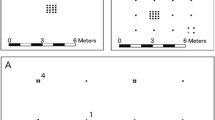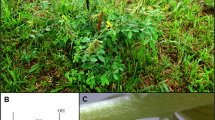Abstract
The resource concentration hypothesis (Root 1973) predicts that specialist herbivorous insects should be more abundant in large patches of host plants, because the insects are more likely to find and stay longer in those patches. Between August 1989 and January 1990 we experimentally tested Root's hypothesis by analyzing the numerical response of four species of herbivorous insects associated with patches of 4, 16, 64 and 225 cabbage plants, Brassica oleracea var. capitata. In addition, we studied the colonization of patches by adults of Plutella xylostella (L.) (Lepidoptera: Plutellidae), and the migration of their larvae in patches of different sizes. No herbivorous insect densities differed significantly with patch size. Adults of P. xylostella colonized all kind of patches equally. Larvae did not migrate between patches, and their disappearance rate did not differ between patches. The resource concentration hypothesis is organism-dependent, being a function of the adult and juvenile herbivore dispersal behavior in relation to the spatial scale of patchiness.
Similar content being viewed by others
References
Andow DA (1990) Population dynamics of an insect herbivore in simple and diverse habitats. Ecology 71:1006–1017
Bach CE (1980) Effect of plant density and diversity on the population dynamics of a specialist herbivore, the striped cucumber beetle, Acalymma vittata (Fab.). Ecology 61:1515–1530
Bach CE (1984) Plant spatial pattern and herbivore population dynamics: plant factors affecting the movement patterns of a tropical cucurbit specialist (Acalymma innubum). Ecology 65: 175–190
Bach CE (1986) A comparison of the response of two tropical specialist herbivores to host plant patch size. Oecologia 68:580–584
Bach CE (1988a) Effect of host plant patch size on herbivore density: patterns. Ecology 69:1090–1102
Bach CE (1988b) Effect of host plant patch size on herbivore density: underlying mechanisms. Ecology 69:1103–1117
Bergelson J, Kareiva P (1987) Barriers to movement and the response of herbivores to alternative cropping patterns. Oecologia 71:457–460
Capman WC, Batzli GO, Simms LE (1990) Responses of the common sooty wing skipper to patches of host plants. Ecology 71: 1430–1440
Cromartie WJ (1975) The effect of stand size and vegetational background on the colonization of cruciferous plants by herbivorous insects. J Appl Ecol 12:517–533
Denno R, Raupp M, Tallamy M (1981) Organization of a guild of sap-feeding insects: equilibrium versus nonequilibrium coexistence. In: Denno RF, Dingle H (eds) Insect life history patterns: habitat and geographic variation. Springer, Berlin Heidelberg New York, pp 151–181
González RH (1989) Insectos y ácaros de importancia agrícola y cuarentenaria en Chile. Ograma, Santiago
Grez AA (1991) Concentración de recursos: efecto del tamaño del parche sobre la densidad de insectos herbívoros. Ms Sc Dissertation, Universidad de Chile, Santiago
Hairston NG (1989) Ecological experiments: purpose, design, and execution. Cambridge University Press, New York
Hassell MP, Southwood TRE (1978) Foraging strategies of insects. Annu Rev Ecol Syst 9:75–98
Hurlbert SH (1984) Pseudoreplication and the design of ecological field experiments. Ecol Monogr 54:187–211
Kareiva P (1985) Finding and losing host plants by Phyllotreta: patch size and surrounding habitat. Ecology 66:1809–1816
Lamb RJ (1989) Entomology of oilseed Brassica crops. Annu Rev Entomol 34:11–229
Lawrence WS, Bach CE (1989) Chrysomelid beetle movements in relation to host-plant size and surrounding non-host vegetation. Ecology 70:1679–1690
MacGarvin M (1982) Species-area relationships of insects on host plants: herbivores on rosebay willowherb. J Anim Ecol 51: 207–223
Maguire LA (1983) Influence of collard patch size on population densities of lepidopteran pests (Lepidoptera: Pieridae, Plutellidae). Environ Entomol 12:1415–1419
Raupp MJ, Denno RF (1979) The influence of patch size on a guild of sapfeeding insects that inhabit the salt marsch grass Spartina patens. Environ Entomol 8:412–417
Risch SJ (1981) Insect herbivore abundance in tropical monocultures and polycultures: an experimental test of two hypotheses. Ecology 62:1325–1340
Root RB (1973) Organization of a plant-arthropod association in simple and diverse habitats: the fauna of collards (Brassica oleracea). Ecol Monogr 43:95–124
Sokal RR, Rohlf FJ (1981) Biometry, 2nd edn. Freeman, San Francisco
Stanton ML (1983) Spatial patterns in the plant community and their effects upon insect search. In: Ahmad S (ed) Herbivorous insects: host-seeking behavior and mechanisms. Academic Press, New York, pp 125–157
Strauss SY, Morrow PA (1988) Movement patterns of an Australian chrysomelid beetle in a stand of two Eucalyptus host species. Oecologia 77:231–237
Talekar NS, Shelton AM (1993) Biology, ecology,a nd management of the diamondback moth. Annu Rev Entomol 38:275–301
Thompson JN (1978) Within-patch structure and dynamics in Pastinaca sativa and resource availability to a specialized herbivore. Ecology 59:443–448
Turchin P (1987) The role of aggregation in the response of Mexican bean beetles to host-plant density. Oecologia 71:577–582
Author information
Authors and Affiliations
Rights and permissions
About this article
Cite this article
Grez, A.A., González, R.H. Resource concentration hypothesis: effect of host plant patch size on density of herbivorous insects. Oecologia 103, 471–474 (1995). https://doi.org/10.1007/BF00328685
Received:
Accepted:
Issue Date:
DOI: https://doi.org/10.1007/BF00328685




